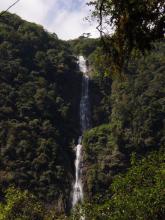Explore Bhutan Cultural Library

This collection contains essays on various genres of oral traditions in Bhutan, as well as other cultural subjects. Each text is linked to relevant places and subjects, such that users can explore the rich tapestry of Bhutanese culture through different media.
Texts in this collection
The list below includes texts from this Collection’s Subcollections.
Lo choe literally means annual religious practice. It is a seasonal celebration when a family gets together to make offerings to its protecting deities and have a festive gathering with its neighbours and community. Thus, it combines both a religious and social event for celebration.
This piece was initially published in Bhutan’s national newspaper Kuensel in a series called "Why we do what we do".
The roles of lozey in traditional Bhutanese conversation, including genre standards as well as a discussion of the merits of their spontaneous composition.
An introduction to lungta (rlung rta), an intangible human trait that can be cultivated through various rituals, including raising/throwing of prayer flags bearing particular symbolic imagery.
The origins and role of lungten (lung bstan) in Bhutanese history and culture.
A summary of the construction methods for mani dangrim, and their perceived functions.
In the Bhutanese culture, the marchang offering is made to launch an auspicious event, mark an important occasion or receive an honoured guest.
This piece was initially published in Bhutan’s national newspaper Kuensel in a series called "Why we do what we do".
The significance and history behind Bhutan's appellation as "The Land of Medicinal Herbs", extracted from Karma Phuntsho's monograph, The History of Bhutan.
A problematizing of the name "Mon" and its application to Bhutan, extracted from Karma Phuntsho's monograph, The History of Bhutan.
Buddhist moenlams are mainly mental aspirations rather than just prayers or supplications to a powerful or superior being. When one does moenlam, one aspires, intends or wishes to do something, be someone or reach somewhere. So Buddhist moenlam involves having a strong and earnest wish.
This piece was initially published in Bhutan’s national newspaper Kuensel in a series called "Why we do what we do".
A summary of the structure and symbolism of the Namchu Wangchen as described in the Kālachakra Tantra.
Part one of a three part series on the meaning, functions and origins of personal names in Bhutan.
Part two of a three part series on the meaning, functions and origins of personal names in Bhutan.
Part three of a three part series on the meaning, functions and origins of personal names in Bhutan, with a focus on titles and honorifics.
A discussion of namthar as a genre as well as the various types of biographical writings that one may encounter in Bhutan's textual corpus.
The role that inention plays in Buddhist practice, from a Bhutanese perspective.
The whole point of going on neykor is to expedite one’s spiritual journey through the physical journey along a powerful place. One’s internal transformation happens more swiftly and more powerfully through association with the power spots.
This piece was initially published in Bhutan’s national newspaper Kuensel in a series called "Why we do what we do".
The significance of the annual Day of the Nine Evils from the Bhutanese cultural perspective.
Ngöndro literally means preliminary or preparatory practice that people should do before taking up the actual practice of Vajrayāna. It prepares a student for the actual practice of Vajrayāna Buddhist meditation, which mainly refers to the meditation on the nature of the mind.
This piece was initially published in Bhutan’s national newspaper Kuensel in a series called "Why we do what we do".
By doing the dedication, one allocates the merits to the recipient and gives up the sole ownership of the merits. In this way, the merit cannot be used up or destroyed by a sudden anger or remorse because it does not just belong to oneself.
This piece was initially published in Bhutan’s national newspaper Kuensel in a series called "Why we do what we do".
An enumeration of the seven subsidiary precious possessions of a monarch or elite person.
A summary of the needs for and means of generating compassion as one of the four immeasurables, as told from the Bhutanese perspective.
An overview of the compilation and contents of the Nyingma Gyubum in Bhutan, as well as an enumeration of its various editions in the country.
In this practice, one makes the offering of the entire universe or world, as one perceives it. The fundamental concept underpinning the maṇḍalaoffering is giving all good things which exists in the entire universe to one’s guru, the Buddha or the Bodhisattvas.
This piece was initially published in Bhutan’s national newspaper Kuensel in a series called "Why we do what we do".
An overview of the function and structure of a standard verse of auspiciousness recited in Bhutan and throughout the Buddhist world.